| | 
Guitars are made up of tonewoods, strings, equipment (metal as well as plastic), as well as electronic devices-- all collaborating to produce a music maker. Every guitar is a little bit different, however there are three basic parts-- the headstock, the neck, and also the body. In this post, we'll take a look at and also explain all three parts as well as their components.
Headstock
Headstock (A).
The headstock sits on top of the neck ( contrary the body) where the tuning machines and nut are installed.
Tuning Machines/Tuning Posts (B).
On a basic guitar, there are adjusting machines that include the tuning articles to hold each string in position and tuning pegs that look to readjust the adjusting.
Nut (C).
The nut is a notched item of plastic or bone mounted where the headstock satisfies the fretboard of the guitar. The nut has notches where the strings are seated. These notches maintain the strings lined up on the fretboard and play a role in the string elevation. It makes an essential payment to the tone given that it is the end factor (on the neck side) of the strings.
Neck.
The neck of a guitar is the lengthy, thin piece of wood in between the headstock and also the body where you'll locate the fretboard, frets, as well as truss rod. Necks are commonly attached to the body with bolts, adhesive, or in some cases both.
Fretboard (D).
The fretboard is connected to the top of the neck and also is normally made from tonewoods like rosewood, maple, or ebony to avoid dents or warping. The fretboard is a separate piece of timber from the neck as well as may coincide or a various kind of wood, such as a maple fretboard on a maple neck, or a rosewood fretboard on a mahogany neck.
Frets (E).
Frets are the metal strips running across the fretboard. When a string is pressed down behind a fret, it transforms the length of that string as well as creates a different note. Many fretboards also have fret markers (either dots or blocks or birds) that mark the location of frets 3, 5, 7, and also 12 ( as well as often much more) for simple referral.
Truss Rod.
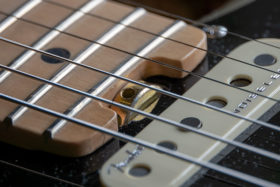
A truss rod is a long, flexible piece of steel that is mounted inside the neck and also runs the length of the neck, helping to keep it from flexing under the stress of the strings. A properly changed truss pole is necessary to any kind of good arrangement and also assists to get rid of things like fret buzz, articulation issues, and also various other playability troubles.
Body.
The body of your guitar plays a big part in the tonal attributes of your instrument. Let's have a look at the parts of the guitar body and afterwards highlight several of the similarities and differences between an acoustic as well as electric guitar body.
Cutaway (F).
The cutaway allows a player to extra easily reach the highest possible fret placements on the neck.
Upper Bout (G).
The top spell is the part of the guitar body that is nearby the neck.
Reduced Bout (H).
The lower round is the largest part of the guitar that is nearest to the string discontinuation at the bridge.
Pickguard (I).
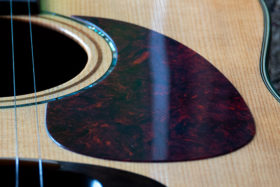
You can consider the pickguard as a guard for your guitar. It is planned to prevent scrapes, dings, as well as wear from the difficult choice of also the most hostile strummer. Pickguards are available in a variety of various shades as well as are an easy upgrade on a lot of electrical guitars. If you're interested in an upgrade, Sweetwater's Guitar Repair Shop enjoys to aid.
Pick-ups (J).
On acoustic guitars the pick-up can be in several locations. On this guitar in the layout, the pick-up lies under the bridge. Typically, electrical guitars come with one, 2, or three pickups, and the placement of the pick-up plays a big part in your guitar audio. Pickups positioned closer to the bridge will certainly appear bright and chimy; whereas, pickups positioned closer to the neck will appear warmer and bassier.
Pickup Selector Switch (K).
If your guitar has multiple pickups, a pickup selector button permits you to involve solitary or several pickup combinations and offers you the ability to access a vast array of tones.
Quantity and also Tone Knobs/Potentiometers (L).
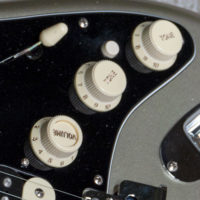
The potentiometers, often described as pots, manage the quantity and tone of your guitar. The tone knob( s) permit you to readjust the quantity of high frequency, or illumination, of your guitar, while the volume knob( s) readjust the overall output of your guitar.
Result Jack (M).
To obtain signal out of a guitar, link one end of a 1/4 ″ guitar cord (TS) to the outcome jack as well as the other end to your amplifier, DI box, pedal or pedalboard, mixer, or taping interface.
Strap Buttons (N).
Strap buttons enable you to affix a strap to your guitar and also are generally situated on the reduced round and upper round of a guitar. It's a wonderful idea to update to band locks if you have a guitar that isn't balanced or if you intend on doing any kind of crazy stage shenanigans throughout your solo. Look into our strap lock options if you're seeking included security.
Following let's concentrate on the distinctions between acoustic and also electric guitars.
Electric Bridge (O).
The electric guitar bridge is the various other discontinuation factor for the string. It is widely crucial, due to the fact that its positioning defines the feel, tone, and also modulation of the guitar. The string runs either via a tailpiece (P) to the saddle, or via the body. Along with the saddle, the bridge likewise aids to call at work and modulation. Electric guitar bridges can have extra functions, like a whammy bar that permits you to raise or decrease the pitch.
Acoustic Bridge (O).
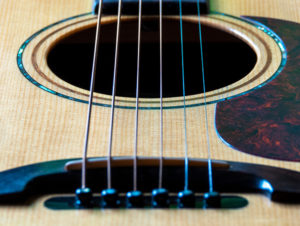
An acoustic guitar bridge holds the saddle as well as safeguards the strings in place using bridge pins. The saddle is normally made from bone, plastic, or some kind of graphite material. The string runs over the saddle and is kept in area by a bridge pin. When a string is tweezed or played, the resonance is moved with the saddle, to the bridge, as well as to the top (soundboard) of the guitar.
Soundhole (Q).
The hole in the top of a guitar is called the soundhole. The hollow body of an acoustic guitar enables the bass frequencies created from the strings to resonate as well as be enhanced and then task via the soundhole, while the leading acts to enhance the mid as well as high frequencies. Some soundholes may be off center or designed differently (like an ƒ-hole).
Strings.
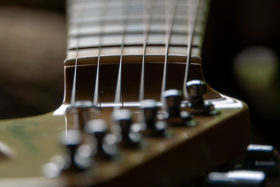
A guitar string typically consists of a slim core with cable twisted around it ( when it comes to bass strings) or simply the core by itself (for greater strings). The thicker the string or core, the reduced the pitch. You can find strings that are roundwound and flatwound and also made from a range of steels, including steel, nickel, and/or bronze-- each with its own sound and qualities. | | | |
|





